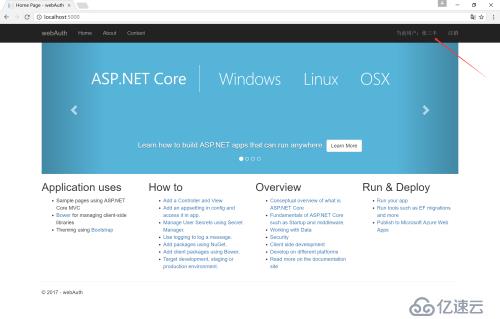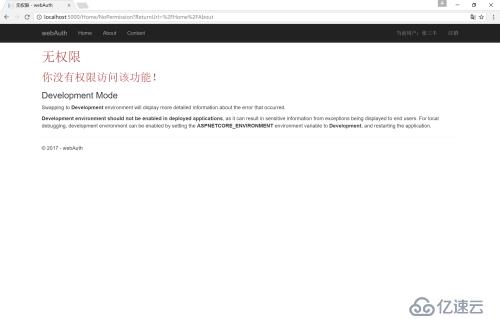您好,登录后才能下订单哦!
密码登录
登录注册
点击 登录注册 即表示同意《亿速云用户服务条款》
本例是用简单角色验证方式来通过用户登录后,获取用户角色,每种角色可以通过[Authorize(Roles = "admin,user")]在Action上来控制访问的权限,也就是说,只有属性这个角色才能访问这个Action。
道先添加Microsoft.AspNetCore.Authentication.Cookies引用
在StartUp.cs的Configure方法中添加
//为验证添加中间件
app.UseCookieAuthentication(new CookieAuthenticationOptions
{
//验证方案名称
AuthenticationScheme = "loginvalidate",
//没有权限时导航的登录action
LoginPath = new Microsoft.AspNetCore.Http.PathString("/login"),
//访问被拒绝后的acion
AccessDeniedPath = new Microsoft.AspNetCore.Http.PathString("/Home/NoPermission"),
AutomaticAuthenticate = true,
AutomaticChallenge = true,
SlidingExpiration = true
});
HomeController中的登录的action实现
using System.Collections.Generic;
using System.Linq;
using Microsoft.AspNetCore.Mvc;
using Microsoft.AspNetCore.Authorization;
using System.Security.Claims;
namespace webAuth.Controllers
{
/// <summary>
/// 本Controller允许admin和user两种角色可以访问
/// </summary>
[Authorize(Roles = "admin,user")]
public class HomeController : Controller
{
public IActionResult Index()
{
return View();
}
/// <summary>
/// aobout只允许user角色访问
/// </summary>
/// <returns></returns>
[Authorize(Roles = "user")]
public IActionResult About()
{
var id = User.Claims.SingleOrDefault(c => c.Type == ClaimTypes.Sid).Value;
ViewData["Message"] = "UserID:"+ id;
return View();
}
/// <summary>
/// contact只允许admin角色访问
/// </summary>
/// <returns></returns>
[Authorize(Roles = "admin")]
public IActionResult Contact()
{
var id=User.Claims.SingleOrDefault(c => c.Type == ClaimTypes.Sid).Value;
ViewData["Message"] = "UserID:"+ id;
return View();
}
public IActionResult NoPermission()
{
return View();
}
/// <summary>
/// 允许所有登录者
/// </summary>
/// <param name="returnUrl">如果用户访问的不是登录页,returnUrl将把这个url传进来,待登录成功后返回这个地址</param>
/// <returns></returns>
[AllowAnonymous]
[HttpGet("login")]
public IActionResult Login(string returnUrl)
{
//判断是否验证
if (!HttpContext.User.Identity.IsAuthenticated)
{
//把返回地址保存在前台的hide表单中
ViewBag.returnUrl = returnUrl;
}
ViewBag.error = null;
return View();
}
/// <summary>
/// 允许所有登录者
/// </summary>
/// <param name="username">用户名</param>
/// <param name="password">密码</param>
/// <param name="returnUrl">返回u</param>
/// <returns></returns>
[AllowAnonymous]
[HttpPost("login")]
public IActionResult Login(string username, string password, string returnUrl)
{
//从数据库验证用户,关取出用户所需要信息
var users = new List<dynamic>() {
new { ID = 1, UserName = "zsf",Password="111", Name = "张三丰", RoleTypeID = 1, RoleType = "admin", RoleTypeName = "管理员" },
new { ID = 2, UserName = "zwj",Password="222", Name = "张无忌", RoleTypeID = 2, RoleType = "user", RoleTypeName = "普通用户" }
};
var user = users.SingleOrDefault(u => u.UserName == username && u.Password == password);
if (user!=null)
{
//登录成功后,设置声明
var claims = new Claim[] {
new Claim(ClaimTypes.UserData,username),
new Claim(ClaimTypes.Role,user.RoleType),
new Claim(ClaimTypes.Name,user.Name),
new Claim(ClaimTypes.Sid,user.ID.ToString())
};
HttpContext.Authentication.SignInAsync("loginvalidate", new ClaimsPrincipal(new ClaimsIdentity(claims, "Cookie")));
HttpContext.User = new ClaimsPrincipal(new ClaimsIdentity(claims));
return new RedirectResult(returnUrl == null ? "/" : returnUrl);
}
else
{
ViewBag.error = "用户名或密码错误!";
return View();
}
}
}
}
Login.cshtml页面如下:
@{
Layout = null;
}
<!DOCTYPE html>
<html>
<head>
<meta charset="utf-8" />
<meta name="viewport" content="width=device-width, initial-scale=1.0" />
<title>登录</title>
<link href="~/lib/bootstrap/dist/css/bootstrap.css" rel="stylesheet" />
<style>
.col-md-12 {
text-align: center;
margin-top: 10px;
}
.input-group {
width: 300px;
margin: 0 auto;
}
.input-group-addon{
width:80px;
}
</style>
</head>
<body>
<form method="post" action="/login">
<div class="container">
<div class="row" >
<div class="col-md-12">
<div class="input-group">
<span class="input-group-addon" id="basic-addon1">用户名</span>
<input type="text" class="form-control" name="username" aria-describedby="basic-addon1">
</div>
</div>
</div>
<div class="row">
<div class="col-md-12">
<div class="input-group">
<span class="input-group-addon" id="basic-addon1">密码</span>
<input type="password" class="form-control" name="password" aria-describedby="basic-addon1">
</div>
</div>
</div>
<div class="row">
<div class="col-md-12">
<div class="input-group" >
<input type="hidden" value="@ViewBag.returnUrl" name="returnUrl" />
<button type="submit" class="btn btn-primary" >登录</button>
</div>
</div>
</div>
@if (ViewBag.error != null)
{
<font color="red">@ViewBag.error</font>
}
</div>
</form>
<script src="~/lib/bootstrap/dist/js/bootstrap.js"></script>
<script src="~/lib/jquery/dist/jquery.js"></script>
</body>
</html>如果在其他页面使用User,可以像下面这样使用
<span>当前用户:@User.Identity.Name</span>
当然也可以从User中查到其他登录时存储的Claim的值
登录成功后

登录成功后访问没有权限页面(当然可以不让这种角色看到不能访问的链接)

免责声明:本站发布的内容(图片、视频和文字)以原创、转载和分享为主,文章观点不代表本网站立场,如果涉及侵权请联系站长邮箱:is@yisu.com进行举报,并提供相关证据,一经查实,将立刻删除涉嫌侵权内容。